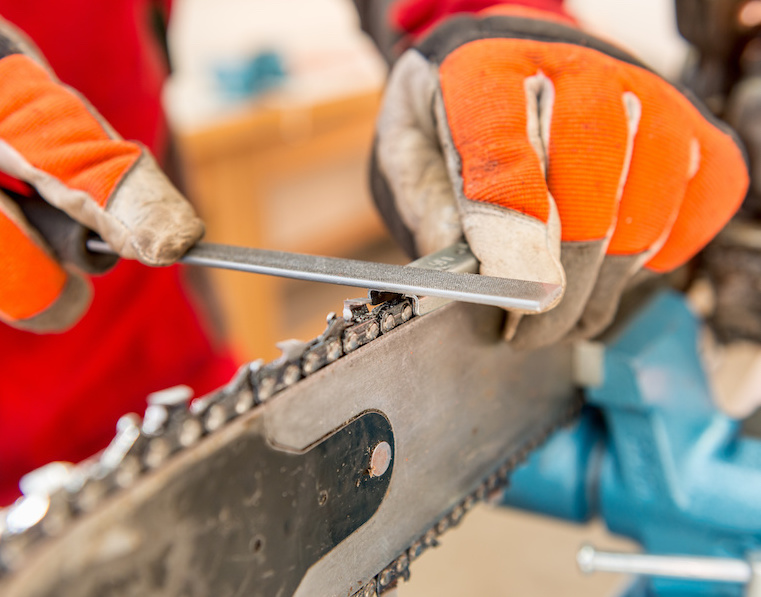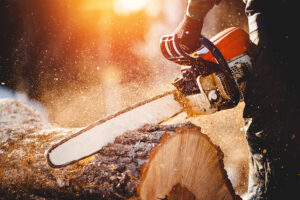Chain Saw Repair and Maintenance

By Tom Doherty
For arborists performing tree pruning, utility line clearance or landscapers clearing out extremely challenging brush, chain saws are a necessary tool to the get the job done. Yet, proper chain saw maintenance and repair is equally as necessary to prevent accidents and ensure reliable performance. Roughly 36,000 people – a good number of whom are green industry professionals – are treated for chain-saw-related injuries each year, according to the Centers for Disease Control and Prevention. As a landscaping or tree care business owner, the burden of providing your workers with proper, in-depth training around necessary chain saw safety, maintenance, and repairs rests on you. The following guide touches on some of the most important tips and industry guidelines for maintaining, servicing, and repairing chain saws in tree care settings.
Safety first: The importance of proactive maintenance
Before performing any chain saw repairs or maintenance, understanding the manufacturer instructions should be the first step for every tree care and landscaping professional. Each brand will have its own controls, internal design and service schedule pertaining to components that must be regularly maintained, including the engine, the chain, the chain brake, the lubrication system and the air filter.

Prior to any work being performed, green industry professionals should conduct a thorough inspection of these core components for any signs of wear, damage or obstruction, as recommended by OSHA. Maintaining a proactive approach of chain saw inspections will help identify possible issues will not only help extend the lifespan of the saw, but also help prevent accidents before they occur. OSHA recommends taking the following precautions before getting started:
- Check all controls, bolts and handles for possible safety issues.
- Verify the chain tension is adjusted according to the manufacturer’s guidelines.
- Ensure the fuel and lubrication system is filled to recommended levels.
- Sharpen the teeth on the chain saw’s chain prior to use.
- Put on personal protective equipment, such as safety glasses, work gloves, hard hats, etc.
Arborists and landscaping workers should always have a fellow professional on site to help monitor performance, whether working at ground level or elevated heights. Additionally, having a second set of eyes available during your tree pruning job helps to minimize the risk of serious chain-saw-related injuries or accidents. As a strict rule of thumb, chain saws should never be operated above shoulder level and certainly should not have adjustments to the chain made while running.
Chainsaw repair and upkeep best practices
In some cases, on-the spot maintenance may be necessary. While inconvenient, some mechanical issues can be resolved rather easily; however, many may require replacement parts and a safe environment to perform proper chain saw repairs. One of the more common maintenance concerns arborists will encounter is a dull chain. A dull chain is particularly dangerous, as it can increase the risk of kickbacks and have a negative impact on the saw’s overall performance. Occasional gas leaks, faulty spark plugs, warped guide bars, and clogged air filters are other common issues to look for in regular maintenance checks. If a chain saw is running rough or having difficulty starting up, an arborist should try to diagnose the root causes before switching out parts or making repairs.
How to sharpen a chain saw
Keeping your chain saw sharp and in working order is not as difficult as it may seem. There are several different methods of sharpening a chain saw, such as filing by hand, using a power sharpener, etc. Bench-top sharpeners may be the most convenient solution, yet arborists who encounter issues in the field will most likely not have that equipment readily available. In such circumstances, keeping a round file of the proper diameter on hand is a quick solution to sharpening the chain saw’s cutting edges while in the field.
- Step 1: Set a sharpening guide on top of the saw chain and rest the file against the cutting edge.
- Step 2: Adjust the file to match the cutting tooth’s angle. Keep in mind that these cutting edges are designed with alternating angles.
- Step 3: Using a slow and steady stroke, push the file forward along the cutting tooth. Repeat this motion five additional times while matching the tooth’s angle.
- Step 4: Move onto the next cutting tooth and repeat steps 1 – 3, making sure the curved edges are clean and shiny.
Chain saw sharpening and repair, like any other skill, takes time and effort to fully master. However, regular maintenance and inspection of your chain saw and its core components will help you develop an eye for preventing issues before they arise. Overall, keeping a sharp chain saw will help to minimize your potential risk of having a serious injury or fatal accident. When in doubt, be sure to consult the manufacturer’s guidelines and recommendations to remain safe during your chain saw repairs.
Tom Doherty serves as the senior vice president, specialty programs of NIP Group with more than 12 years of experience in the insurance industry, specializing in the business development and client growth sectors. Doherty is a dynamic and versatile insurance program leader with the rare combination of specialty insurance and technology expertise. He has driven the development and growth of many differentiated insurance programs to address the unmet needs of customers and brokers.
Learn more about what landscaping insurance solutions LandPro can offer your business.


